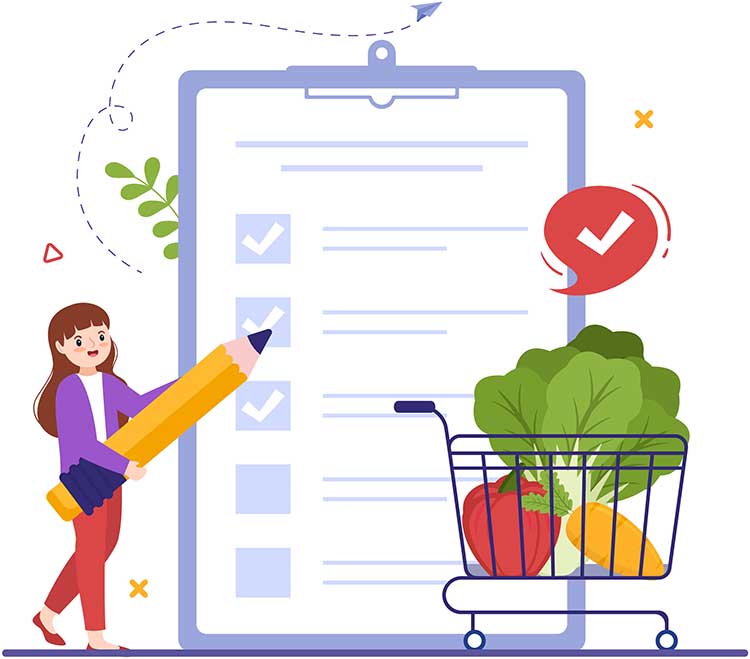Which Grocery Stores Offer the Best Prices and Quality?
Last updated November 2025

Our latest comparison of Boston area supermarkets’ prices and quality is in the bag. Consumers’ Checkbook researchers shopped stores using a 150-item list to compare prices. To evaluate stores on quality of products and service, we surveyed our members. The figures below summarize our findings; for details, see our Ratings Tables. Here’s what we found:
Market Basket and Wegmans stand out.
Despite a now decade-long Succession-esque power struggle among its ownership family, Market Basket continues to match its low prices with favorable ratings for quality. Although Market Basket wasn’t one of the area’s top-scoring chains for quality of produce or meat, it did receive higher marks for our survey question on “overall quality.” Market Basket also remains one of the area’s least expensive chains: Its prices were 15 percent lower than the average at all stores we shopped.
Wegmans continues its slow-but-steady East Coast expansion and now has five stores in the Boston area. Since opening its first Massachusetts location in 2011, the Rochester-based chain has consistently earned high ratings from its customers for quality. In our latest survey, 81 percent of its surveyed customers judged it “superior” overall.
Although Wegmans’ prices aren’t among the lowest in the region, it remains competitive. On average, its prices were about the same as Shaw’s, three percent lower than Stop & Shop, and 17 percent lower than Whole Foods, but 10 percent higher than Walmart, 15 percent higher than Market Basket, and 17 percent higher than Price Rite.
ALDI offers the biggest savings.
The German-based discounter, ubiquitous in most of western Europe, focuses on low costs, and our survey found ALDI quite inexpensive: For our shopping list, its prices were 28 percent lower than the all-store average. ALDI’s per-unit prices were even as low as BJ’s and Costco’s.
These savings are partly explained by ALDI’s smaller-format stores, which have much lower overhead costs than conventional supermarkets.
ALDI also benefits from different expectations. Shoppers at Market Basket, Stop & Shop, Walmart, etc., expect to always find their favorite brands on the shelves. Like Trader Joe’s, ALDI carries mostly its own brands, not national-brand products. ALDI does offer some national brands, but overall, selection is limited. In other words, you’ll find some of the most popular brands (Coke, Heinz ketchup, Hellmann’s mayo, etc.) at ALDI, but probably only in one size.
Instead, ALDI’s shoppers trade that quirkiness for comparable very-low-priced products. (To account for brand differences, we used a modified market basket to compare ALDI and Trader Joe’s prices with conventional supermarkets; click here for more info.)

Other price standouts: Hannaford, Price Rite, Target, and Walmart.
Price Rite, which offers a somewhat odd assortment of its own products and independent brands, plus steeply discounted major national-brand products, offered prices about 17 percent lower than the average at all other stores we surveyed. Market Basket had prices about 15 percent lower than the all-store average, Walmart 10 percent lower, and Hannaford and Target each eight percent lower.
For a family that spends $300 per week at the supermarket, a 17 percent price difference totals savings of $2,652 per year; a 10 percent price difference totals $1,560 a year.
Trader Joe’s remains popular.
Seventy-nine percent of survey respondents rated the funky-and-fun chain “superior” for “overall quality.” Although not a price leader in the area, TJ’s prices were about the same as Wegmans and Shaw’s, and about four percent lower than Stop & Shop.
Stop & Shop locations we surveyed charge different prices.
We surveyed two Stop & Shop stores. The lower-priced Stop & Shop had prices that averaged about five percent lower than its higher-priced location. Shaw’s prices were consistent among the locations we shopped for it.

Whole Foods and Roche Bros. remain expensive.
When Amazon purchased Whole Foods in 2017, many experts predicted the combination would punish its supermarket competition by combining Whole Foods’ solid reputation with Amazon’s pursuit of distribution perfection. Many consumers hoped they’d pay Amazon-like prices for Whole Foods-quality products. That hasn’t materialized.
Whole Foods built a loyal following by offering high-quality produce, meat, prepared foods, and generic staples. It continues to receive high marks in our surveys of consumers for produce and meat quality, but our price survey found that Whole Foods remains among the most expensive choice among stores we shopped: Its overall prices were about 17 percent higher than the average prices at all stores we surveyed, or about 17 percent higher than top-rated Wegmans and 38 percent higher than Market Basket.
Roche Bros. also received raves from its surveyed customers for quality—84 percent judged it “superior” overall—but its prices were 18 percent higher than the all-store average.
Most large chains received dreadful ratings from their customers. Target scored lowest; Hannaford, Shaw’s, Star Market, Stop & Shop, and Walmart also got abysmal ratings.
Target was rated “superior” overall by only 12 percent of its surveyed customers; the other chains mentioned above were each rated “superior” overall by 40 percent or fewer.
We also checked out warehouse clubs, looked at unique stores Trader Joe’s and ALDI, and examined grocery delivery options.
Check out the other articles in our “Grocery Stores” category and our ratings tables for info on all the local grocery options, how we rated them, and tips on saving no matter where you shop.


